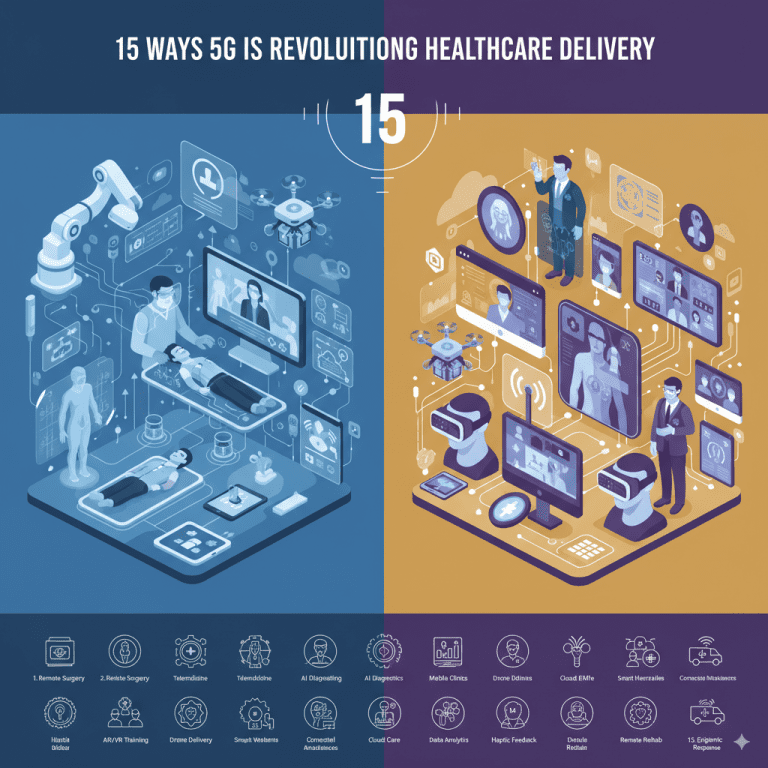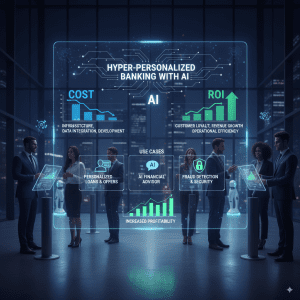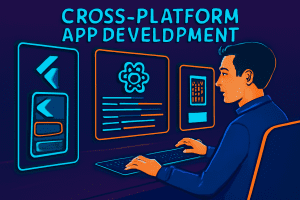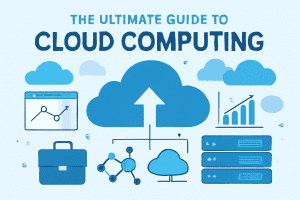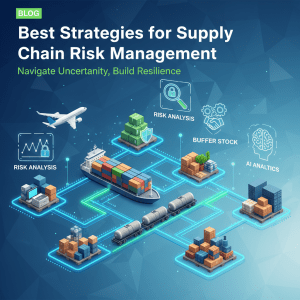Introduction
The healthcare industry is undergoing a seismic transformation powered by the emergence of 5G connectivity. The fifth generation of wireless networks offers blazing speeds, ultra-low latency, and the ability to connect unprecedented numbers of devices—all of which unlock new efficiencies and innovations in patient care. With a rapidly expanding global 5G healthcare market projected to surge from $70.94 billion in 2025 to nearly $390 billion by 2034, forward-looking providers are reimagining everything from diagnostics and surgery to patient monitoring and data management. This blog explores 15 practical ways 5G is revolutionizing healthcare delivery, empowering professionals and patients, and creating a smarter, more connected medical ecosystem.
Real-Time Remote Patient Monitoring
-
5G networks support continuous remote patient monitoring (RPM) by seamlessly connecting wearables and IoT devices.
-
Real-time transmission of vitals allows care teams to detect issues early and intervene before complications arise.
-
Example: Heart monitors send instant readings via connected medical platforms, enabling faster doctor responses.
High-Fidelity Telemedicine and Virtual Consultations
-
Ultra-clear 4K+ video with almost zero lag dramatically enhances virtual medical visits.
-
Doctors can visually inspect skin, wounds, or rashes in detail, building trust and accuracy in remote diagnosis.
-
Example: Leading telehealth providers use 5G to connect diagnostic equipment during video consults.
Connected Ambulances and Next-Gen Emergency Services
-
5G-equipped ambulances serve as “mobile ERs,” sharing live HD video and critical patient data with hospitals in real time.
-
Paramedics receive expert guidance from remote clinicians during transport, improving life-saving outcomes.
-
Example: University Hospitals in Birmingham piloted remote ultrasound guidance in 5G ambulances.
Instantaneous Access to Electronic Health Records (EHR)
-
5G enables clinicians to access full EHRs—including large medical images—on tablets or devices anywhere in the hospital within seconds.
-
Faster access means faster, more informed clinical decisions and workflow efficiency.
-
Example: Rush University Medical Center’s private 5G boosts Epic system accessibility.
The Rise of the Internet of Medical Things (IoMT)
-
5G enables thousands of connected IoMT devices in smart hospitals, powering smart beds, infusion pumps, and environmental sensors.
-
Real-time data aggregation creates a digital twin of entire operations, driving clinical and operational optimization.
-
Example: Philips HealthSuite manages data from millions of devices over robust 5G networks.
Democratizing Expertise with Remote and Robotic Surgery
-
Ultra-low 5G latency makes remote robotic surgery a reality.
-
Surgeons in one location can perform delicate procedures on patients hundreds of miles away.
-
Example: In China, remote thyroid surgeries have been performed thanks to 5G.
Advanced Predictive Analytics for Patient Care
-
Real-time sensor and medical record data flow enables AI-powered predictive models for sepsis risk, patient deterioration, and resource allocation.
-
Enhanced clinician decision-making leads to proactive, personalized interventions.
-
Example: The U.S. Veterans Affairs living lab uses 5G to power predictive analytics in chronic care.
Immersive Medical Training with AR and VR
-
Medical education evolves with 5G-fueled AR/VR, enabling virtual dissection, simulated surgeries, and lag-free team training.
-
Complex procedures can be practiced in virtual operating rooms globally.
-
Example: Multi-user platforms like GE HealthCare’s OmnifyXR allow remote collaborative training.
Automated Hospital Kiosks and Self-Serve Stations
-
5G keeps smart kiosks and check-in stations fast and responsive, even during peak times.
-
Automating patient intake, co-payment, and navigation streamlines operations and frees up staff.
-
Example: Boston Children’s Hospital uses a hybrid 5G network for real-time registration and payments.
Digital Twins for Personalized Treatment Planning
-
Virtual patient “digital twins” simulate organs or systems for personalized planning and risk-free surgery rehearsal.
-
High-throughput 5G transfers large imaging and modeling data seamlessly between systems and clinicians.
Resilient Supply Chain and Smart Inventory Management
-
5G-powered sensors and tags track medical equipment, medications, and PPE in real time, reducing waste and shortages.
-
Automated stock alerts and predictive maintenance lower costs and improve readiness.
Enhanced Medical Imaging and Faster Diagnostics
-
5G dramatically reduces the time to transfer massive imaging files, accelerating diagnosis and treatment.
-
Enables seamless collaboration among radiologists and AI-driven image analysis.
Seamless Collaboration Between Healthcare Professionals
-
Real-time, high-definition video and data sharing accelerate collaborative diagnosis, second opinions, and multidisciplinary decision-making.
-
Teams work seamlessly—even across continents—improving complex case outcomes.
Improved Patient Data Security and Privacy
-
5G’s network slicing and advanced encryption ensure that critical patient data is isolated from general traffic.
-
Hospitals can deploy Zero Trust frameworks to verify every app, user, and device before access.
-
Example: Advanced hospital networks use hardware-level isolation and separate encryption keys for security.
Supporting Rural and Underserved Communities
-
Fixed wireless access (FWA) over 5G delivers high-speed Internet to remote clinics, enabling telemedicine, specialist consults, and remote diagnostics.
-
Rural patients gain access to advanced care previously only available in major cities.
-
Example: T-Mobile’s Project 10Million brings 5G health services and virtual appointments to rural schools and clinics.
Conclusion
5G is redefining the healthcare playbook, transforming both the patient and provider experiences with speed, scale, and intelligence never before possible. From telemedicine and robotic surgery to predictive analytics, immersive training, and robust supply chain management, the applications are far-reaching and evidence-based. Forward-thinking organizations are already moving quickly to integrate 5G, gaining efficiency, resilience, and a decisive edge in the pursuit of delivering better, more accessible care. Now is the time for healthcare leaders to prioritize bold adoption—and to build a digital health future where connectivity, compassion, and innovation go hand in hand.
Ready to future-proof healthcare operations or deliver next-gen patient experiences? Contact a digital healthcare transformation expert for an in-depth 5G strategy assessment today.
FAQ
Q1: What is the biggest impact of 5G in healthcare?
A: Remote patient monitoring and telemedicine provide continuous, real-time care and expand access to specialists for rural and urban populations alike.
Q2: Is 5G safe and secure for patient information?
A: Yes, 5G offers advanced security features such as network slicing and end-to-end encryption, helping protect sensitive medical data against cyber threats.
Q3: How does 5G benefit hospital operations?
A: 5G streamlines data flows, enhances collaboration, enables instant access to EHRs, and supports smart logistics—resulting in faster patient throughput, fewer errors, and reduced administrative burden.
Q4: Can 5G enable surgeries performed from remote locations?
A: Absolutely. 5G’s ultra-low latency allows surgeons to operate on patients miles away, democratizing access to cutting-edge specialized care.
Q5: What challenges do hospitals face when adopting 5G?
A: Infrastructure costs, systems interoperability, and cybersecurity are major hurdles—but phased rollouts, open standards, and technology partnerships can solve these issues
